2006 CHEVROLET TAHOE ECU
[x] Cancel search: ECUPage 7 of 540
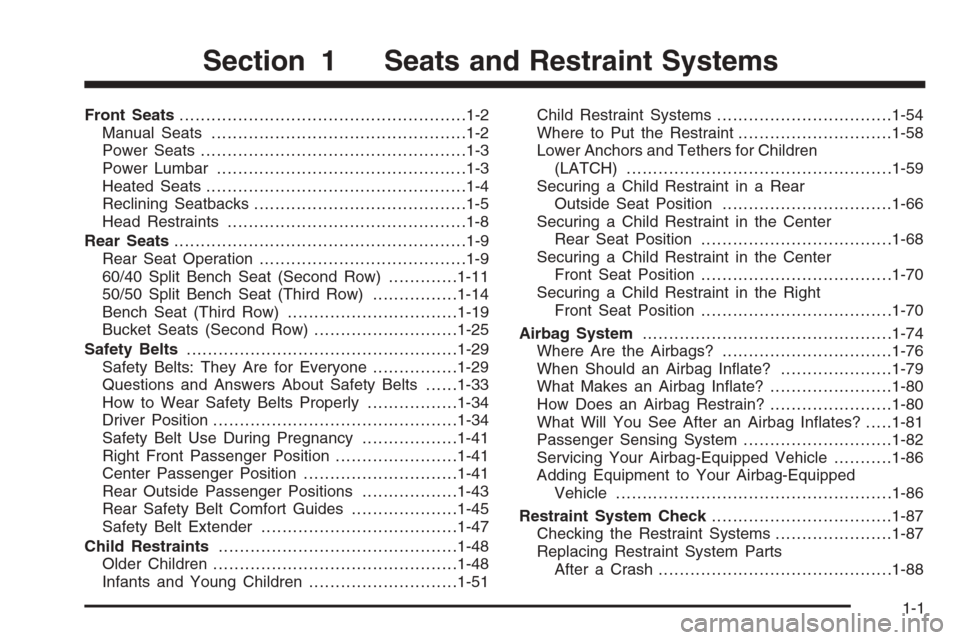
Front Seats......................................................1-2
Manual Seats................................................1-2
Power Seats..................................................1-3
Power Lumbar ...............................................1-3
Heated Seats.................................................1-4
Reclining Seatbacks........................................1-5
Head Restraints.............................................1-8
Rear Seats.......................................................1-9
Rear Seat Operation.......................................1-9
60/40 Split Bench Seat (Second Row).............1-11
50/50 Split Bench Seat (Third Row)................1-14
Bench Seat (Third Row)................................1-19
Bucket Seats (Second Row)...........................1-25
Safety Belts...................................................1-29
Safety Belts: They Are for Everyone................1-29
Questions and Answers About Safety Belts......1-33
How to Wear Safety Belts Properly.................1-34
Driver Position..............................................1-34
Safety Belt Use During Pregnancy..................1-41
Right Front Passenger Position.......................1-41
Center Passenger Position.............................1-41
Rear Outside Passenger Positions..................1-43
Rear Safety Belt Comfort Guides....................1-45
Safety Belt Extender.....................................1-47
Child Restraints.............................................1-48
Older Children..............................................1-48
Infants and Young Children............................1-51Child Restraint Systems.................................1-54
Where to Put the Restraint.............................1-58
Lower Anchors and Tethers for Children
(LATCH)..................................................1-59
Securing a Child Restraint in a Rear
Outside Seat Position................................1-66
Securing a Child Restraint in the Center
Rear Seat Position....................................1-68
Securing a Child Restraint in the Center
Front Seat Position....................................1-70
Securing a Child Restraint in the Right
Front Seat Position....................................1-70
Airbag System...............................................1-74
Where Are the Airbags?................................1-76
When Should an Airbag In�ate?.....................1-79
What Makes an Airbag In�ate?.......................1-80
How Does an Airbag Restrain?.......................1-80
What Will You See After an Airbag In�ates?.....1-81
Passenger Sensing System............................1-82
Servicing Your Airbag-Equipped Vehicle...........1-86
Adding Equipment to Your Airbag-Equipped
Vehicle....................................................1-86
Restraint System Check..................................1-87
Checking the Restraint Systems......................1-87
Replacing Restraint System Parts
After a Crash............................................1-88
Section 1 Seats and Restraint Systems
1-1
Page 24 of 540
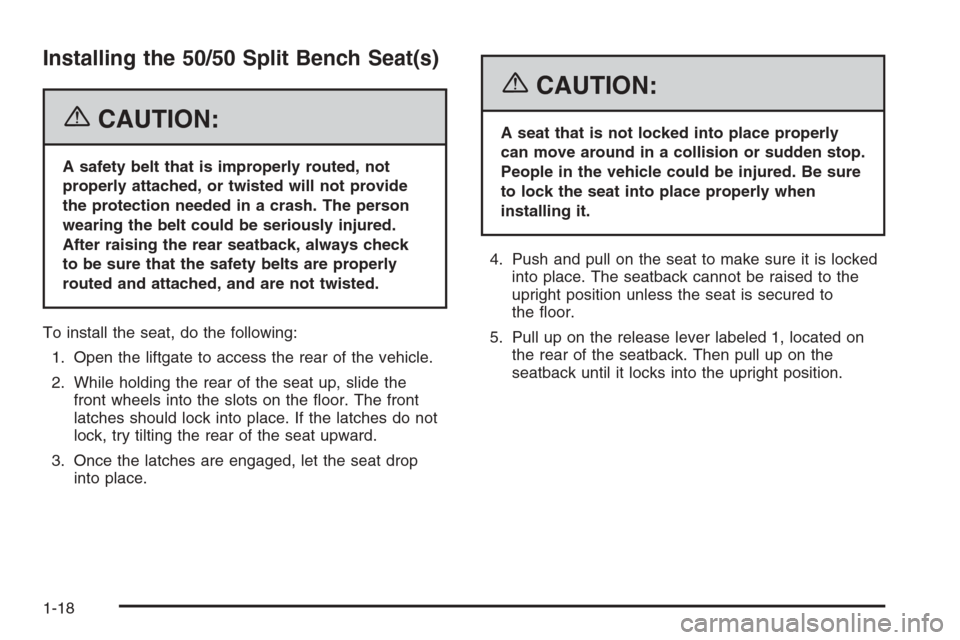
Installing the 50/50 Split Bench Seat(s)
{CAUTION:
A safety belt that is improperly routed, not
properly attached, or twisted will not provide
the protection needed in a crash. The person
wearing the belt could be seriously injured.
After raising the rear seatback, always check
to be sure that the safety belts are properly
routed and attached, and are not twisted.
To install the seat, do the following:
1. Open the liftgate to access the rear of the vehicle.
2. While holding the rear of the seat up, slide the
front wheels into the slots on the �oor. The front
latches should lock into place. If the latches do not
lock, try tilting the rear of the seat upward.
3. Once the latches are engaged, let the seat drop
into place.
{CAUTION:
A seat that is not locked into place properly
can move around in a collision or sudden stop.
People in the vehicle could be injured. Be sure
to lock the seat into place properly when
installing it.
4. Push and pull on the seat to make sure it is locked
into place. The seatback cannot be raised to the
upright position unless the seat is secured to
the �oor.
5. Pull up on the release lever labeled 1, located on
the rear of the seatback. Then pull up on the
seatback until it locks into the upright position.
1-18
Page 30 of 540
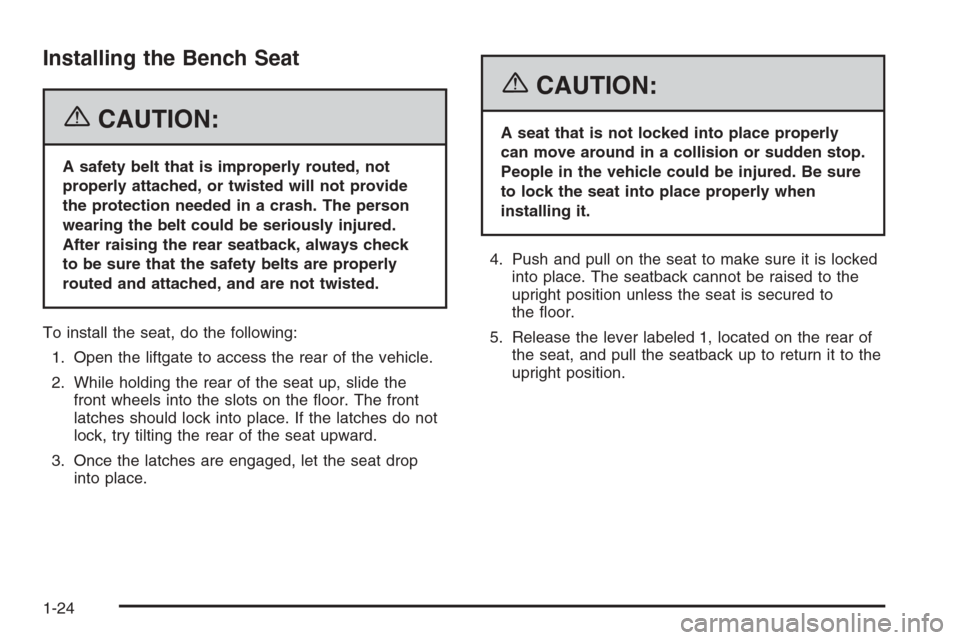
Installing the Bench Seat
{CAUTION:
A safety belt that is improperly routed, not
properly attached, or twisted will not provide
the protection needed in a crash. The person
wearing the belt could be seriously injured.
After raising the rear seatback, always check
to be sure that the safety belts are properly
routed and attached, and are not twisted.
To install the seat, do the following:
1. Open the liftgate to access the rear of the vehicle.
2. While holding the rear of the seat up, slide the
front wheels into the slots on the �oor. The front
latches should lock into place. If the latches do not
lock, try tilting the rear of the seat upward.
3. Once the latches are engaged, let the seat drop
into place.
{CAUTION:
A seat that is not locked into place properly
can move around in a collision or sudden stop.
People in the vehicle could be injured. Be sure
to lock the seat into place properly when
installing it.
4. Push and pull on the seat to make sure it is locked
into place. The seatback cannot be raised to the
upright position unless the seat is secured to
the �oor.
5. Release the lever labeled 1, located on the rear of
the seat, and pull the seatback up to return it to the
upright position.
1-24
Page 41 of 540
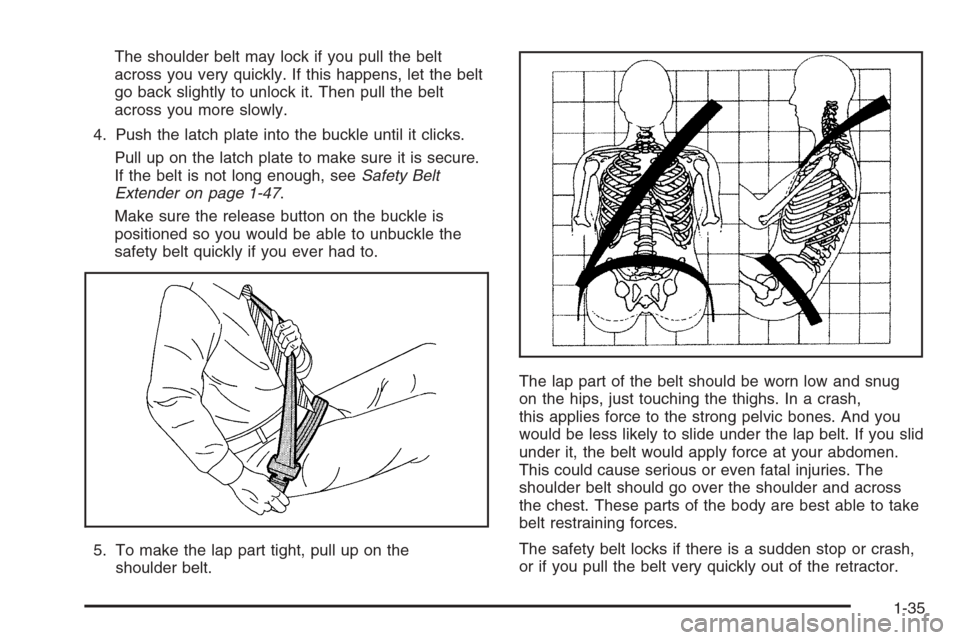
The shoulder belt may lock if you pull the belt
across you very quickly. If this happens, let the belt
go back slightly to unlock it. Then pull the belt
across you more slowly.
4. Push the latch plate into the buckle until it clicks.
Pull up on the latch plate to make sure it is secure.
If the belt is not long enough, seeSafety Belt
Extender on page 1-47.
Make sure the release button on the buckle is
positioned so you would be able to unbuckle the
safety belt quickly if you ever had to.
5. To make the lap part tight, pull up on the
shoulder belt.The lap part of the belt should be worn low and snug
on the hips, just touching the thighs. In a crash,
this applies force to the strong pelvic bones. And you
would be less likely to slide under the lap belt. If you slid
under it, the belt would apply force at your abdomen.
This could cause serious or even fatal injuries. The
shoulder belt should go over the shoulder and across
the chest. These parts of the body are best able to take
belt restraining forces.
The safety belt locks if there is a sudden stop or crash,
or if you pull the belt very quickly out of the retractor.
1-35
Page 50 of 540

2. Push the latch plate into the buckle until it clicks.
Pull up on the latch plate to make sure it is secure.
When the shoulder belt is pulled out all the way,
it will lock. If it does, let it go back all the way and
start again.
If the belt is not long enough, seeSafety Belt
Extender on page 1-47.
Make sure the release button on the buckle is
positioned so you would be able to unbuckle the
safety belt quickly if you ever had to.
3. To make the lap part tight, pull up on the
shoulder part.The lap part of the belt should be worn low and snug
on the hips, just touching the thighs. In a crash,
this applies force to the strong pelvic bones. And you
would be less likely to slide under the lap belt. If you slid
under it, the belt would apply force at your abdomen.
This could cause serious or even fatal injuries. The
shoulder belt should go over the shoulder and across
the chest. These parts of the body are best able to take
belt restraining forces.
The safety belt locks if there is a sudden stop or a crash,
or if you pull the belt very quickly out of the retractor.
1-44
Page 53 of 540

{CAUTION:
A safety belt that is not properly worn may
not provide the protection needed in a crash.
The person wearing the belt could be seriously
injured. The shoulder belt should go over
the shoulder and across the chest. These
parts of the body are best able to take belt
restraining forces.4. Buckle, position, and release the safety belt as
described inRear Outside Passenger Positions
on page 1-43. Make sure that the shoulder
belt crosses the shoulder.
To remove and store the comfort guides, squeeze the
belt edges together so that you can take them out of
the guides. Make sure you remove the comfort guide
from the belt before you fold a rear seat down or use
an easy-entry seat, if your vehicle has one.
Safety Belt Extender
If the vehicle’s safety belt will fasten around you,
you should use it.
But if a safety belt is not long enough, your dealer will
order you an extender. It is free. When you go in to
order it, take the heaviest coat you will wear, so
the extender will be long enough for you. To help avoid
personal injury, do not let someone else use it, and
use it only for the seat it is made to �t. The extender has
been designed for adults. Never use it for securing
child seats. To wear it, just attach it to the regular safety
belt. For more information, see the instruction sheet
that comes with the extender.
1-47
Page 57 of 540
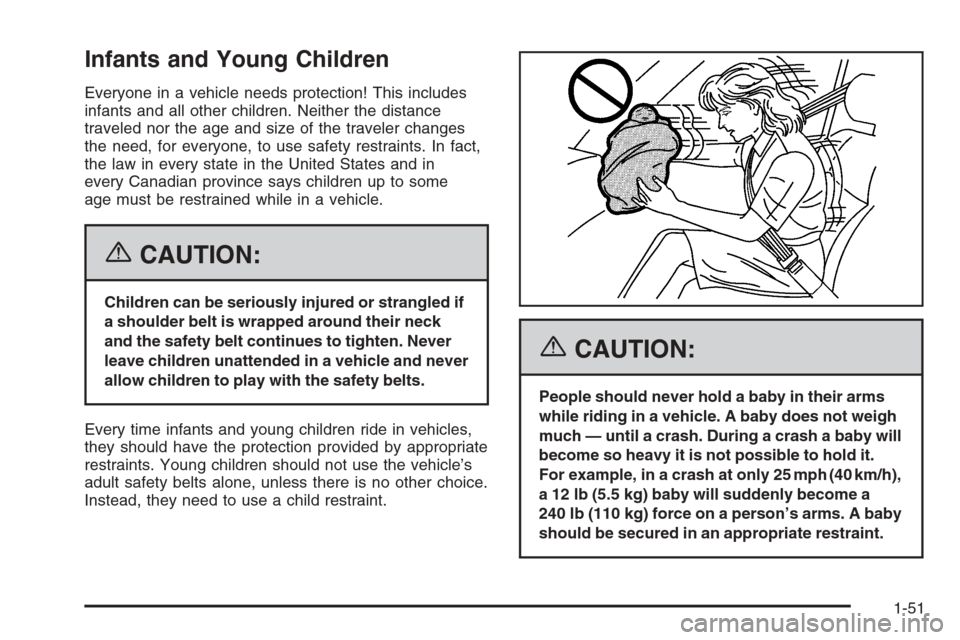
Infants and Young Children
Everyone in a vehicle needs protection! This includes
infants and all other children. Neither the distance
traveled nor the age and size of the traveler changes
the need, for everyone, to use safety restraints. In fact,
the law in every state in the United States and in
every Canadian province says children up to some
age must be restrained while in a vehicle.
{CAUTION:
Children can be seriously injured or strangled if
a shoulder belt is wrapped around their neck
and the safety belt continues to tighten. Never
leave children unattended in a vehicle and never
allow children to play with the safety belts.
Every time infants and young children ride in vehicles,
they should have the protection provided by appropriate
restraints. Young children should not use the vehicle’s
adult safety belts alone, unless there is no other choice.
Instead, they need to use a child restraint.
{CAUTION:
People should never hold a baby in their arms
while riding in a vehicle. A baby does not weigh
much — until a crash. During a crash a baby will
become so heavy it is not possible to hold it.
For example, in a crash at only 25 mph (40 km/h),
a 12 lb (5.5 kg) baby will suddenly become a
240 lb (110 kg) force on a person’s arms. A baby
should be secured in an appropriate restraint.
1-51
Page 59 of 540
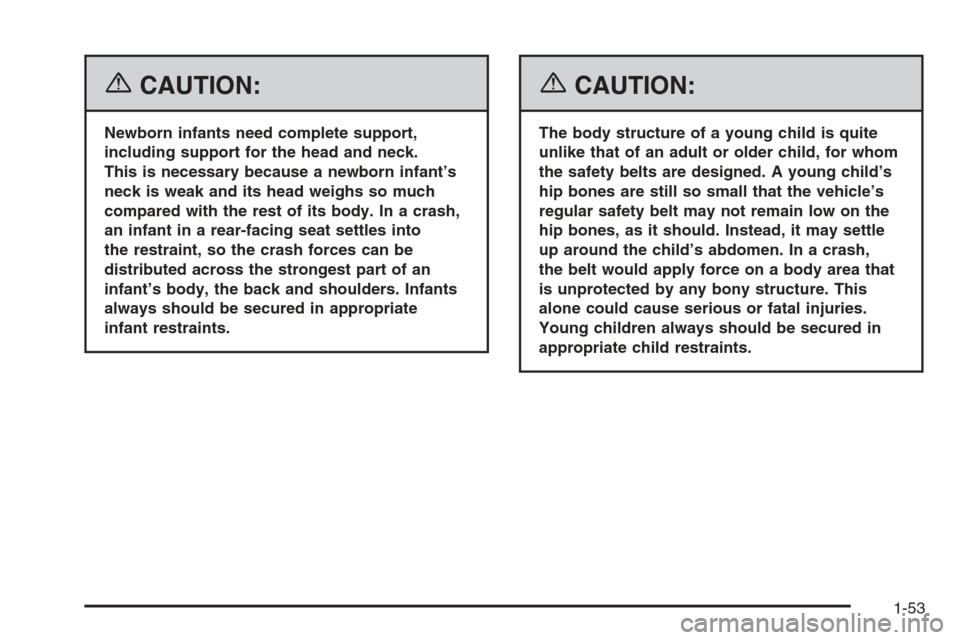
{CAUTION:
Newborn infants need complete support,
including support for the head and neck.
This is necessary because a newborn infant’s
neck is weak and its head weighs so much
compared with the rest of its body. In a crash,
an infant in a rear-facing seat settles into
the restraint, so the crash forces can be
distributed across the strongest part of an
infant’s body, the back and shoulders. Infants
always should be secured in appropriate
infant restraints.
{CAUTION:
The body structure of a young child is quite
unlike that of an adult or older child, for whom
the safety belts are designed. A young child’s
hip bones are still so small that the vehicle’s
regular safety belt may not remain low on the
hip bones, as it should. Instead, it may settle
up around the child’s abdomen. In a crash,
the belt would apply force on a body area that
is unprotected by any bony structure. This
alone could cause serious or fatal injuries.
Young children always should be secured in
appropriate child restraints.
1-53